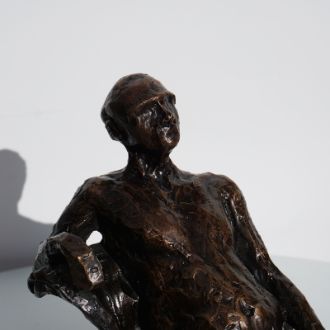Bronze Casting – The Lost Wax Process
March 15 2024 – Paul Mooney

Bronze sculpture is among one of the most popular mediums within the art world – they are long lasting, difficult to damage, and don't lose value.
A wide range of artists use bronze as their chosen medium to work with, and a variety of techniques and methods exist to cast bronze artworks, and among them the most common is the 'Lost Wax' method.
The lost wax method of casting is as popular as it is ancient. Dating back as far as c. 3700 BC, this simple and effective process has become extremely widespread.
The process has a 12-step working method which can be used to make intricate and elaborate designs suitable to almost any type of piece an artist would wish to produce.

The 12-Step Method
The artist begins by making the original model of their design, traditionally in wax or clay.
A mould is made of the original model using two shell like halves, one soft - normally made of latex or silicone - and one hard which is commonly plaster. It is common for larger works to be made using more than one mould.
While producing the moulds a shim with keys is placed between the two parts to allow the two pieces to be put back together accurately.
Molten wax is poured into the two halves and moved around to allow an even layer to set on the mould – normally the aim is for 3mm of wax to reside on the mould. Excess wax is then poured away, leaving a hollow wax copy of the piece inside. The wax copy is then removed from the mould.
The wax copy is then “chased” – this is where a heated metal tool is used to hide any imperfections and remove the line showing where two pieces have been moulded together. Any additional pieces that were moulded separately would also be added at this point.
The wax copy is next 'sprued' with a tree-like structure of wax that will eventually provide paths for the molten casting material to flow and for air to escape. The carefully planned spruing usually begins at the top with a wax "cup," which is attached by wax cylinders to various points on the wax copy.
The sprued wax copy is then dipped into a “slurry” of silica and then into a sand-like stucco – the combination of these two materials is known as the ceramic shell mould. This process is repeated until 1.5 cm of the ceramic shell mould coats the wax copy.
Once there is a suitably thick ceramic shell of the wax copy, it is fired in a kiln. This hardens the ceramic shell to enable it to be filled with molten bronze later. At this point, it is also where the process gets it's name. The wax model that was inside of the ceramic shell melts and drains away through the sprued vents/tunnels and is lost. Hence the ‘lost wax process’.
Before the molten bronze is added, the mould will first be tested using water to find any weak points or holes where leaks may occur. Any damage can be repaired, holes patched or additional holes drilled.
When secure and strong, the shell is then heated once again in the kiln to remove any remaining moisture, and ensure the cast is at a similar temperature to the molten bronze.
The final mould is now ready for casting. First the bronze is melted in a furnace until molten, usually to a temperature of 1200 °C. It is then transferred into a crucible, to be transported and poured into the mould. Once the mould is filled with a sufficient amount of bronze, it is then left to cool.
Once cool, the bronze casting is now released by hammering away the shell and removing the sprues. The bronze in the sprues will be melted back down and used again, but the ceramic shell is lost.
The metal chasing process is now used, removing any signs that the piece has been through the casting process. Imperfections or pits from air bubbles can be removed by filing the surface.
From here, the artist may wish to look at finishing or putting a patina on their work.
To find out more watch this excellent short video on lost wax bronze sculpture by the Victoria and Albert Museum.


0 comments